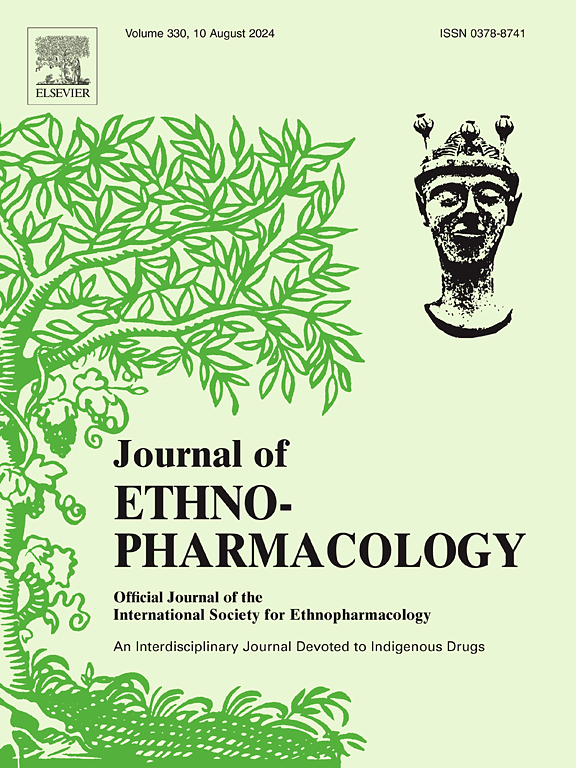Differential impact of extracts from distinct Sceletium tortuosum chemotypes on central neurotransmitter concentrations in C57BL/6 mice
IF 4.8
2区 医学
Q1 CHEMISTRY, MEDICINAL
引用次数: 0
Abstract
Ethnopharmacology relevance
Sceletium tortuosum, also known as kanna, or kougoed, has long been an integral part of the traditional medicinal practices of the San and Khoikhoi peoples of Southern Africa. Among the various Sceletium species, S. tortuosum is used for its mood-enhancing properties, attributed to the structurally related mesembrine-type alkaloids found therein. While significant research has focused on mesembrine and mesembrenone, the therapeutic potential of extracts from plants that produce more of the so-called “minor alkaloids”, remains unexplored.
Aim of the study
To assess the CNS modulatory effects of two chemotypes of S. tortuosum, wild-collected from two different geographic locations in South Africa (Touwsrivier and De Rust), each featuring different alkaloid profiles and with elevated minor alkaloid concentrations.
Materials and methods
Extracts from these chemotypes, as well as a vehicle control and a commercial extract, were administered to four groups of mice for 35 days. Mice were then euthanised, and their frontal cortices, striata and hippocampi dissected. Serotonin, dopamine, noradrenaline, glutamate, and gamma-aminobutyric acid (GABA) concentrations were analysed using LC-MS.
Results
Both chemotypes, compared to both control and commercial extract exposure, robustly increased noradrenaline and decreased GABA concentrations in all regions of the mouse brain analysed.
Conclusion
This finding may support a mood-enhancing effect of S. tortuosum and indicates its potential to modulate anxiety and stress processing, attention, and alertness. Alkaloid profiling further suggests that the mesembrine alcohols and sceletium A4 may be important contributors in driving these neurochemical changes.
不同化学型刺荆提取物对C57BL/6小鼠中枢神经递质浓度的差异影响。
民族药理学相关性:龙骨草,也被称为kanna或kougoed,长期以来一直是南部非洲San和Khoikhoi民族传统医学实践的组成部分。在各种各样的蛇尾草中,由于其结构相关的间膜类生物碱,蛇尾草被用于改善情绪的特性。虽然重要的研究集中在间膜和间膜啡酮上,但产生更多所谓的“小生物碱”的植物提取物的治疗潜力仍未得到探索。该研究的目的:评估两种化学型的S. tortuosum的中枢神经系统调节作用,这两种化学型采集自南非的两个不同地理位置(Touwsrivier和De Rust),每种化学型都具有不同的生物碱谱和升高的次要生物碱浓度。材料和方法:将这些化学型的提取物,以及载体对照和商业提取物,给予四组小鼠35天。然后对老鼠实施安乐死,并解剖它们的额皮质、纹状体和海马体。使用LC-MS分析血清素、多巴胺、去甲肾上腺素、谷氨酸和γ -氨基丁酸(GABA)浓度。结果:与对照组和商业提取物暴露相比,两种化学型都显著增加了小鼠大脑所有区域的去甲肾上腺素和降低了GABA浓度。结论:这一发现可能支持一种情绪增强作用,表明其潜在的调节焦虑和应激处理,注意力和警觉性。生物碱分析进一步表明,间膜醇和硒A4可能是驱动这些神经化学变化的重要贡献者。
本文章由计算机程序翻译,如有差异,请以英文原文为准。
求助全文
约1分钟内获得全文
求助全文
来源期刊

Journal of ethnopharmacology
医学-全科医学与补充医学
CiteScore
10.30
自引率
5.60%
发文量
967
审稿时长
77 days
期刊介绍:
The Journal of Ethnopharmacology is dedicated to the exchange of information and understandings about people''s use of plants, fungi, animals, microorganisms and minerals and their biological and pharmacological effects based on the principles established through international conventions. Early people confronted with illness and disease, discovered a wealth of useful therapeutic agents in the plant and animal kingdoms. The empirical knowledge of these medicinal substances and their toxic potential was passed on by oral tradition and sometimes recorded in herbals and other texts on materia medica. Many valuable drugs of today (e.g., atropine, ephedrine, tubocurarine, digoxin, reserpine) came into use through the study of indigenous remedies. Chemists continue to use plant-derived drugs (e.g., morphine, taxol, physostigmine, quinidine, emetine) as prototypes in their attempts to develop more effective and less toxic medicinals.
 求助内容:
求助内容: 应助结果提醒方式:
应助结果提醒方式:


